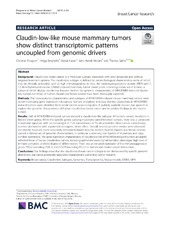| dc.contributor.author | Fougner, Christian | en_US |
| dc.contributor.author | Bergholtz, Helga | en_US |
| dc.contributor.author | Kuiper, Raoul | en_US |
| dc.contributor.author | Norum, Jens Henrik | en_US |
| dc.contributor.author | Sørlie, Therese | en_US |
| dc.date.accessioned | 2020-06-11T17:28:52Z | |
| dc.date.available | 2020-06-11T17:28:52Z | |
| dc.date.issued | 2019-07-31 | |
| dc.Published | Fougner C, Bergholtz H, Kuiper R, Norum JH, Sørlie T. Claudin-low-like mouse mammary tumors show distinct transcriptomic patterns uncoupled from genomic drivers. Breast Cancer Research. 2019;21(85) | eng |
| dc.identifier.issn | 1465-5411 | |
| dc.identifier.issn | 1465-542X | |
| dc.identifier.uri | https://hdl.handle.net/1956/22547 | |
| dc.description.abstract | Background Claudin-low breast cancer is a molecular subtype associated with poor prognosis and without targeted treatment options. The claudin-low subtype is defined by certain biological characteristics, some of which may be clinically actionable, such as high immunogenicity. In mice, the medroxyprogesterone acetate (MPA) and 7,12-dimethylbenzanthracene (DMBA)-induced mammary tumor model yields a heterogeneous set of tumors, a subset of which display claudin-low features. Neither the genomic characteristics of MPA/DMBA-induced claudin-low tumors nor those of human claudin-low breast tumors have been thoroughly explored. Methods The transcriptomic characteristics and subtypes of MPA/DMBA-induced mouse mammary tumors were determined using gene expression microarrays. Somatic mutations and copy number aberrations in MPA/DMBA-induced tumors were identified from whole exome sequencing data. A publicly available dataset was queried to explore the genomic characteristics of human claudin-low breast cancer and to validate findings in the murine tumors. Results Half of MPA/DMBA-induced tumors showed a claudin-low-like subtype. All tumors carried mutations in known driver genes. While the specific genes carrying mutations varied between tumors, there was a consistent mutational signature with an overweight of T>A transversions in TG dinucleotides. Most tumors carried copy number aberrations with a potential oncogenic driver effect. Overall, several genomic events were observed recurrently; however, none accurately delineated claudin-low-like tumors. Human claudin-low breast cancers carried a distinct set of genomic characteristics, in particular a relatively low burden of mutations and copy number aberrations. The gene expression characteristics of claudin-low-like MPA/DMBA-induced tumors accurately reflected those of human claudin-low tumors, including epithelial-mesenchymal transition phenotype, high level of immune activation, and low degree of differentiation. There was an elevated expression of the immunosuppressive genes PTGS2 (encoding COX-2) and CD274 (encoding PD-L1) in human and murine claudin-low tumors. Conclusions Our findings show that the claudin-low breast cancer subtype is not demarcated by specific genomic aberrations, but carries potentially targetable characteristics warranting further research. | en_US |
| dc.language.iso | eng | eng |
| dc.publisher | BMC | eng |
| dc.rights | Attribution CC BY | eng |
| dc.rights.uri | http://creativecommons.org/licenses/by/4.0/ | eng |
| dc.subject | Breast cancer | eng |
| dc.subject | Claudin-low | eng |
| dc.subject | Subtypes | eng |
| dc.subject | Genomics | eng |
| dc.subject | Transcriptomics | eng |
| dc.subject | Mouse models | eng |
| dc.subject | DMBA | eng |
| dc.subject | MPA | eng |
| dc.title | Claudin-low-like mouse mammary tumors show distinct transcriptomic patterns uncoupled from genomic drivers | en_US |
| dc.type | Peer reviewed | |
| dc.type | Journal article | |
| dc.date.updated | 2019-12-13T13:58:51Z | |
| dc.description.version | publishedVersion | en_US |
| dc.rights.holder | Copyright 2019 The Author(s) | |
| dc.identifier.doi | https://doi.org/10.1186/s13058-019-1170-8 | |
| dc.identifier.cristin | 1741612 | |
| dc.source.journal | Breast Cancer Research | |

